初中英语人教版七年级下册课堂教学设计
- 格式:doc
- 大小:55.50 KB
- 文档页数:12
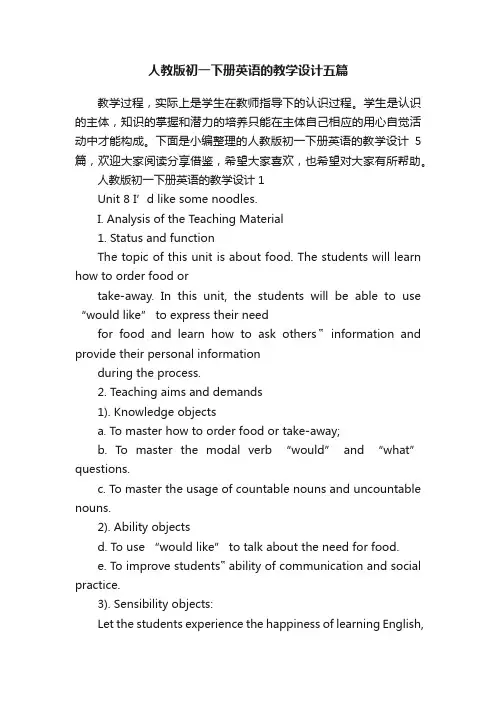
人教版初一下册英语的教学设计五篇教学过程,实际上是学生在教师指导下的认识过程。
学生是认识的主体,知识的掌握和潜力的培养只能在主体自己相应的用心自觉活动中才能构成。
下面是小编整理的人教版初一下册英语的教学设计5篇,欢迎大家阅读分享借鉴,希望大家喜欢,也希望对大家有所帮助。
人教版初一下册英语的教学设计1Unit 8 I’d like some noodles.I. Analysis of the T eaching Material1. Status and functionThe topic of this unit is about food. The students will learn how to order food ortake-away. In this unit, the students will be able to use “would like” to express their needfor food and learn how to ask others‟information and provide their personal informationduring the process.2. Teaching aims and demands1). Knowledge objectsa. To master how to order food or take-away;b. To master the modal verb “would” and “what” questions.c. To master the usage of countable nouns and uncountable nouns.2). Ability objectsd. To use “would like” to talk about the need for food.e. To improve students‟ ability of communication and social practice.3). Sensibility objects:Let the students experience the happiness of learning English,cultivate their abilityto do things and foster the spirit of cooperation in group activities.3. Teaching difficult points and focus:1)To learn the names of food and the countable and uncountable nouns.2)To learn how to order food.3)To use “would like” to express their need for food and learn how to order food.II. Target Language1) what would you/he/they like to eat?I‟d /He‟d /They‟d like some...2) What kind of noodles would you/he/they like?I‟d/He‟d /They‟d like beef and tomato noodlesIV. Vocabularynoodles, beef, chicken, mutton, potatoes, tomato, cabbage,carrot, dumplings, porridge, soup, green tea, orange juice, would like…V. Teaching Time45 minutesVI. Teaching ProceduresStep 1. Warm up.1) Show some pictures about sports and let the students answer the questions below:After doing these sports, what‟s your feeling?Are you tired ?Are you hungry?2) Let the students thinking the question: If you are hungry, what would you like to eat?3) Show some pictures of food that they have learned.Step 2. Lead into.1)T: “No food left! But don‟t worry, let‟s go to the restaurant to have a big meal.Look! What can you see in the restaurant?Yes, There are many kinds of food there. You can choose whatever you like”.2)Show the new words.3)Questions:A: What kind of vegetables/meat/food/drink would you like?B: I‟d like some…Let the students to learn the names of food and the countable and uncountable nouns. Let the students make some dialogue.Step 3. Let’s chant.Step 4. Noodle House.1) Show some pictures about noodle specials.meat+vegetables → special1/special2….(let the students to guess the meaning of the word …special ‟)2) Make dialogueA: What kind of noodles would you like?B: I‟d like…and…noodles.Step 5. Pairwork and guessing game1) Pairwork . (Make dialogues.)2) Game: Who is the winner?Ask a boy and a girl come before the blackboard, and then ask two students to make adialogues. The boy or the girl who find the right special will win one score….aftersome pairwork, see who is the winner? The boy or the girl.3) Guessing game.Step 6. Role Play (In the Nodle House)A customer and a waiter. (Make a dialogue)Let the students express their need for food and learn how to order food.Step 7. SummaryStep 8. ApothegmStep 9 A Flash → “I’m hungry”人教版初一下册英语的教学设计2课前准备教师:准备游戏时所用的图片(食物、蔬菜、动物)。
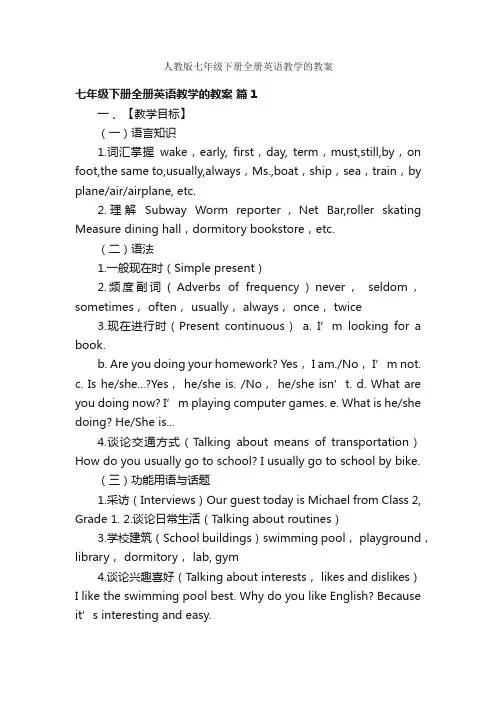
人教版七年级下册全册英语教学的教案七年级下册全册英语教学的教案篇1一、【教学目标】(一)语言知识1.词汇掌握wake,early, first,day, term,must,still,by,on foot,the same to,usually,always,Ms.,boat,ship,sea,train,by plane/air/airplane, etc.2.理解Subway Worm reporter,Net Bar,roller skating Measure dining hall,dormitory bookstore,etc.(二)语法1.一般现在时(Simple present)2.频度副词(Adverbs of frequency)never,seldom,sometimes, often, usually, always, once, twice3.现在进行时(Present continuous)a. I’m loo king for a book.b. Are you doing your homework? Yes, I am./No,I’m not.c. Is he/she...?Yes, he/she is. /No,he/she isn’t.d. What are you doing now? I’m playing computer games.e. What is he/she doing? He/She is...4.谈论交通方式(T alking about means of transportation)How do you usually go to school? I usually go to school by bike.(三)功能用语与话题1.采访(Interviews)Our guest today is Michael from Class 2, Grade 1.2.谈论日常生活(Talking about routines)3.学校建筑(School buildings)swimming pool, playground,library, dormitory, lab, gym4.谈论兴趣喜好(Talking about interests, likes and dislikes)I like the swimming pool best. Why do you like English? Because it’s interesting and easy.5.借物(Borrowing things)How long can I keep it? Two weeks.6.新闻(News)、海报(Poster)Attention,please! Here is the news.7.谈论学校活动、科目和时间表(Talking about school activities,subjects and timetable)8.谈论学校生活(Talking about school life)(四)能力培养【听】能听懂谈论校园生活中比较熟悉的话题,识别主题,获取主要信息。
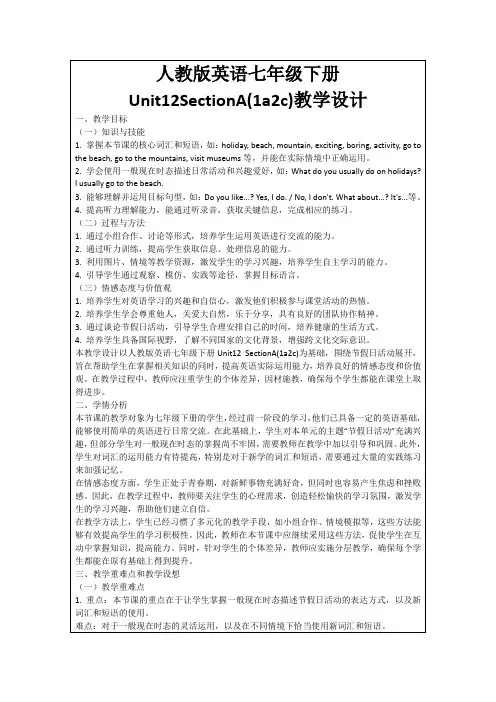

2024年春学期人教版英语七年级下册教学计划附教学进度表一、学情分析本学期我担任本班英语学科教学工作。
本学期本班共有X名学生,其中男生X名,女生X名。
学生学情相对平衡。
大多数学生基础较为扎实,对英语课的认识和理解也逐渐深入,能大胆尝试和探究问题。
部分学生基础比较薄弱,阅读理解能力、文字组织和表达能力、写作能力等不强,短时期难以有较大的提高。
本学期要注重提高全体学生的英语素养。
采取“分层式”教学方式,培养学生在生活中运用英语的能力,使学生懂得英语对生活的服务关系,发挥语言的交际功能,更好适应社会。
同时,还要培养学生英文文学欣赏的能力。
英语基础知识和能力的训练要更进一步,注重重要语法知识和重点句型的灵活运用和进行英语表达方式的综合训练,并落实到实际运用上。
二、教学内容与教材分析七年级下册共12个单元,加上复习单元2个,文化背景知识和学习策略等局部补充材料。
全书采取任务型语言教学模式,融汇话题、交际功能和语言结构,形成了一套循序渐进的生活化的学习程序。
每个单元都列出明确的语言目标,主要的功能工程与语法结构,需要掌握的根本词汇,并分为A、B两局部。
A局部是根本的语言内容,B局部是知识的扩展和综合的语言运用。
每个单元还有selfcheck局部,供学生自我检测本单元所学的语言知识之用。
它采用“语言的输入——学生的消化吸收——学生的语言输出”为主线编排的。
通过确定languageGoal,采用听、说、读、写,自我检测等手段,有效提高语言习得者的学习效率,有利于习得者的语言产出,表达了以学生为主体的思想。
三、教学目标1、获得英语中的基本理论、概念、原理和规律等方面的学问,明白并关注这些学问在生产、生活和社会中的应用。
2、学会将实践生活中遇到的实际问题转化为英语问题、从而通过英语问题解决实际问题,体验知识的探究及其推理过程并学会在实际问题进行应用。
3、初步具有英语操作的基本技能。
肯定的科学探究和实践才能,养成良好的科学思维习惯。
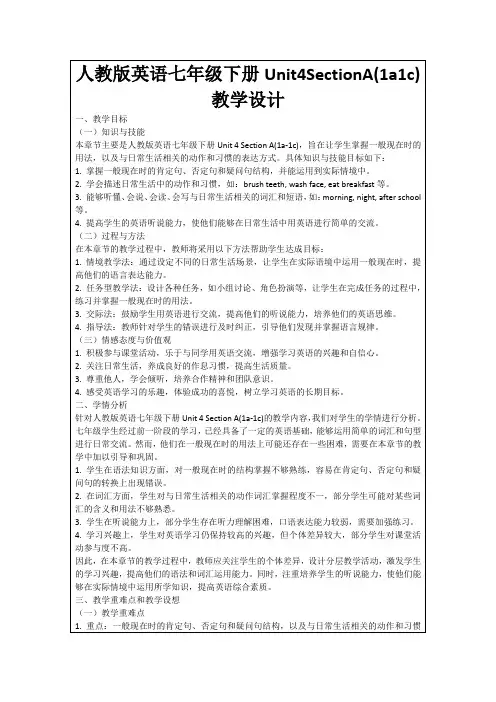
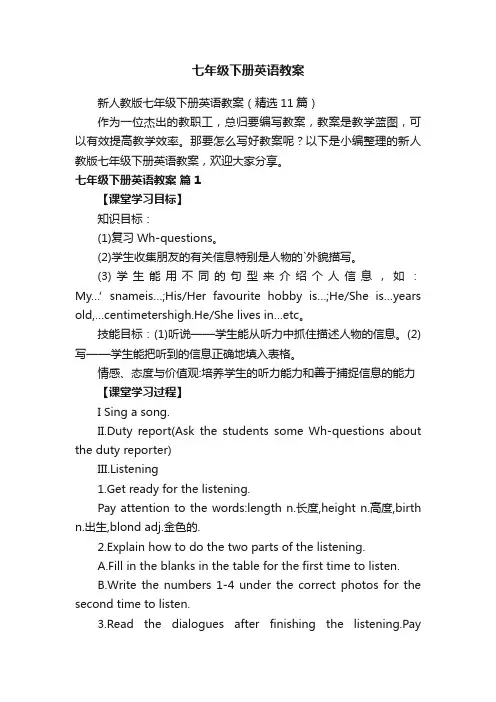
七年级下册英语教案新人教版七年级下册英语教案(精选11篇)作为一位杰出的教职工,总归要编写教案,教案是教学蓝图,可以有效提高教学效率。
那要怎么写好教案呢?以下是小编整理的新人教版七年级下册英语教案,欢迎大家分享。
七年级下册英语教案篇1【课堂学习目标】知识目标:(1)复习Wh-questions。
(2)学生收集朋友的有关信息特别是人物的`外貌描写。
(3)学生能用不同的句型来介绍个人信息,如:My…’snameis…;His/Her favourite hobby is…;He/She is…years old,…centimetershigh.He/She lives in…etc。
技能目标:(1)听说——学生能从听力中抓住描述人物的信息。
(2)写——学生能把听到的信息正确地填入表格。
情感、态度与价值观:培养学生的听力能力和善于捕捉信息的能力【课堂学习过程】I Sing a song.II.Duty report(Ask the students some Wh-questions about the duty reporter)III.Listening1.Get ready for the listening.Pay attention to the words:length n.长度,height n.高度,birth n.出生,blond adj.金色的.2.Explain how to do the two parts of the listening.A.Fill in the blanks in the table for the first time to listen.B.Write the numbers 1-4 under the correct photos for the second time to listen.3.Read the dialogues after finishing the listening.Payattention to the Wh-questions.IV.Practice in pairs.1.Practice the dialogues in pairs.You:…Your deskmate:…You:What colour is your hair?Your deskmate:It’s_________(brown).You:How long is your hair?Yourdeskmate:It’s_________(very long).You:What colour are your eyes?Yourdeskmate:_____________(Brown).You:How tall are you?Yourdeskmate:I’m___________(155)cmtall.You:Where are you from?Yourdeskmate:I am from_________(theUK).You:What’s your favourite sport?Yourdeskmate:_____________(Tennis).You:What’s your best subject?Yourdeskmate:…You:…Yourdeskmate:…2.Then fill in the information in the table.Name AgeAppearanceHobbyBest subjectDream job3.Introduce your deskmate to the classMy deskmate is______________.He/She is____________.He/She has________________hairand___________eyes.His/Her favourite hobby is____________His/Her best subject is_____________.And he/she wants to be_____________.【Homework】Describe one of your favorite teachers in our school!My favourite teacher________________________________________________________________ _____________________________________七年级下册英语教案篇2【学习目标】:1、熟练掌握本课13个单词.2、谈论对方喜欢或不喜欢的食物。

人教版七年级英语下册全册教案Unit1 Where is your pen pal from?Topic:Countries, nationalities, and languagesFunctions:Talk about countries, nationalities and languagesAsk and tell about where people liveStructure:Where's/Where're ...from?Where does/do ...from?What questions----What language does/do ...speak?Target language:Where is she from? She is from....Where does she live? She lives in....What language does she speak? She speaks....V ocabulary:words about countries, languagesTeaching design:The whole unit needs 5 periods, 4 for new lessons and 1 for testPeriod 1 ( 1a----Grammar Focus )Key points:Where is your/John's pen pal from? He/She is from...Where does he/she live? He/She lives in....(Homework for preview)Pre-task:Let the Ss give themselves pen pals and they should write down their pen pals' information, such as their names, countries and cities they live even the language they speak.T can give the Ss an example meanwhile T gives the different countries which can be used by the Ss. T gives the Ss Chinese words for the countries, they are following: 加拿大,法国,日本,美国,澳大利亚,新加坡,英国,中国( The Ss can look them up in the dictionary if they are new for them)The example is following:Name: Curry MurayAge: 75From(Nationality): the United StatesCity: New YorkLanguage: EnglishTeaching Steps:Key points:Where is your/John's pen pal from? He/She is from...Where does he/she live? He/She lives in....(Homework for preview)Pre-task:Let the Ss give themselves pen pals and they should write down their pen pals' information, such as their names, countries and cities they live even the language they speakT can give the Ss an example meanwhile T gives the different countries which can be used by the Ss. T gives the Ss Chinese words for the countries, they are following: 加拿大,法国,日本,美国,澳大利亚,新加坡,英国,中国( The Ss can look them up in the dictionary if they are new for them)The example is following:Name: Curry MurayAge: 75From(Nationality): the United StatesCity: New YorkLanguage: EnglishTeaching Steps:Step 1 Leading-inThe information of the teacher's own pen pal's information."I have a pen pal. His name is Curry Muray. He is from the United States.Do you have a pen pal? Where is your pen pal from? What's your pen pal's name?"Different students say the information about their own pen pals. T should choose the different countries. T writes the different countries on the Bb(both Chinese and English)Step 2 LearningSection A 1a Learn the new words on the Bb. The new words are: pen pal; Canada; France; Japan; the United States(the US/the USA/America); Australia; Singapore; the United Kingdom(the U.K./Great Britain/England)Pay attention to the pronuciation of the new words.Step 3 Listening1b Listen and circle the countries in 1a they learnedStep 4 CompetitionTwo groups of students to write the new words to see which group does better. First write down the Chinese words with looking at the English meanings, then write down the English words with looking at the Chinese meanings.(This step is a memory game. It can help the Ss consolidate the new words they learned)Step 5 Pairwork1c Practise the following conversation:---Do you have a pen pal? ---Yes, I do.---Where's your pen pal's from? ----He/She is from ....(Write it down on the Bb)First T has a conversation with one student as an example then let the Ss practise in pairs. At last let several pairs do it again in class.Step 6 Leading-inRevise the countries names with looking at the Bb. Then T writes down the city names on the Bb. Let the Ss try to find out which countries the cities are in. The city names are following:Toronto; Paris; Tokyo; New York; Sydney; Singapore; London;Step 7 Learning2a Learn the city names together with the whole class just like Step 2 2b Listen and circle the cities and countries2c Listen and complete the chartHave a similar competition to consolidate the new words in this part.Step 8 PairworkT has a conversation with one student like the following:---Do you have a pen pal? ---Yes, I do.---What's your pen pal's name? ---His/Her name is....---Where is your pen pal from? ---He/She is from...---Where does he/she live? ---He/She lives in....(Write it down on the Bb)Let the Ss practise after the T's example in pairs then several pairs do it in class.Step 9 ExerciseMy pen pal is from Australia.(划线提问)John's pen pal is from Japan. (划线提问)He lives in Paris. (划线提问)Homework:Read and copy the new words .Copy the sentences in Grammar FocusMake up the questions about Jodie in 2c The questions are:Does Jodie have a pen pal? Where is Jodie's pen pal from? Where does he/she live? What's his/her name?(This one can be chosen by themselves) Unit 2 Where's the post office?Language goalThis unit students leam to ask for and give directions(方向) on the street. New languageIs there a bank near here? Yes, there's a bank on Center Street, Where's the supermarket? It's next to the library.Is there a pay phone in the neighbhood?Yes, it's on Bridge Street on the right.locations in the neighborhood such as post office, hotel,video arcade.Descriptive words such as new, old, dirty, clean.Descriptions of location such as across from, next to,BetweenRecycled languageWhat are you doing?Do you want to ...?Section AAsk two rows of three students each to stand facing each other in the front of the classroom. Point to students standing in front and ask the class to repeat the questions and answers.Example 1Teacher: Where'sYang Li? (Point to two students standing beside each other.) Yang Li is next to Li Peng.Example 2Teacher: Where's Zheng Wen? (Point to two students in different lines facing each other.)Zheng Wen is across from Sheng Lin.Example 3Teacher: Where's Lin Jiahui? (Point to one student standing between two other students.) Lin Jiahui is between Sheng Lin and Li Dai.la This activity introduces the key vocabulary.Focus attention on the picture. Ask students to name as many of the places they see in the picture as they can.Then name all the places and ask students to repeat.Point out the numbered list of words. Say each one and ask students to repeat.Then ask students to match each word or phrase on the list with one of the pictures. Say, Write the letter of each place in the picture next to the correct word or words on the list. Point out the sample answer f.Check the answers.1b This activity gives students practice listening to and understanding the target language.Point out the buildings and other locations in the picture. Say the name of each one to the class.Say, Now I will play recordings of three conversations. Listen carefully and circle the picture of each place you hear on the tape..Play the recording the first time. Students only listen.Play the recording a second time. This tine ask students to listen and circle the items they hear on the picture.Correct the answers.These items should be circle:video arcade, post office, supermarket.Tapescript(录音稿)Convernation 1A: Is there a video arcade on Fifth Avenue?B: Yes, there is.Conversation 2A: Is there a post office near here?B: Yes, there is. There's one on Bridge Street.Conversation 3A: Is there a supermarket on Center Street?B: No, there isn't.1C This activity provides guided oral practice using the target language.Point to the different locations shown in the picture.Ask different students to name each one. If necessary,say the name and ask the student to repeat.Point to the question and answer In the example conversation and ask a pair of students to read the conversation to the class. Ask other pairs of students to repeat the activity if you wish.Ask students to work in pairs. Say, First one person asks a question and then the other person takes a turn.Demonstrate(示范)the activity. Point to the picture and ask. Is there a post office near here? Then choose a student to answer. Guide the student to say, Yes,there's a post office on Bridge Street.As students work, move around the room and check progress(进展情况). Help students understand how to locate things on the map, if necessary.Ask several students to say some of their questions and answers for the class.教学后记:教学方法有问题?教了这么多年的英语,总幻想有一种方法,能让学生轻轻松松把英语学好。
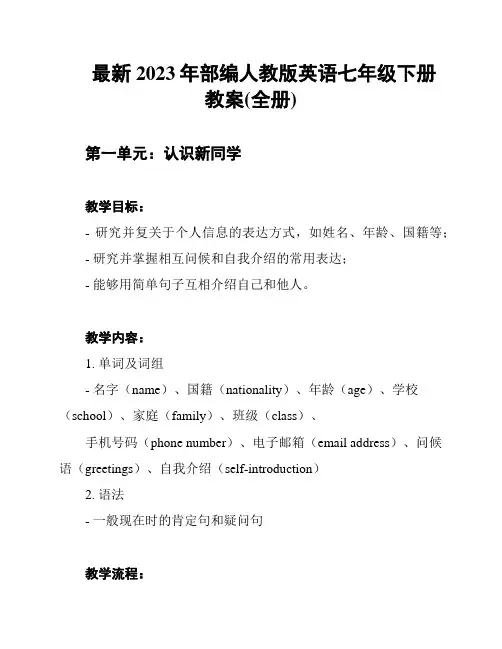
最新2023年部编人教版英语七年级下册教案(全册)第一单元:认识新同学教学目标:- 研究并复关于个人信息的表达方式,如姓名、年龄、国籍等;- 研究并掌握相互问候和自我介绍的常用表达;- 能够用简单句子互相介绍自己和他人。
教学内容:1. 单词及词组- 名字(name)、国籍(nationality)、年龄(age)、学校(school)、家庭(family)、班级(class)、手机号码(phone number)、电子邮箱(email address)、问候语(greetings)、自我介绍(self-introduction)2. 语法- 一般现在时的肯定句和疑问句教学流程:1. 导入新课,介绍并复相关单词和词组。
2. 模仿示范,带领学生用一般现在时谈论个人信息。
3. 练相互问候和自我介绍。
4. 进行小组活动,让学生互相介绍自己和同学。
5. 梳理语法知识,引导学生理解一般现在时的构成和用法。
6. 进行语法练,巩固学生对一般现在时的掌握。
7. 总结本节课的内容,布置相关作业。
教学资源:- 《最新2023年部编人教版英语七年级下册》教材- 多媒体课件- 黑板和白板- 学生练册注:以上内容仅为简要介绍,具体的教案细节请参考教材及教师指导手册。
以上是《最新2023年部编人教版英语七年级下册教案(全册)》第一单元的简要内容。
本单元旨在帮助学生复习和掌握关于个人信息的表达方式,以及相互问候和自我介绍的常用表达。
通过多种教学活动和练习,学生将能够用简单句子互相介绍自己和他人,并掌握一般现在时的构成和用法。
详细的教案内容请参考教材及教师指导手册。

七年级下册英语教案人教版大全4篇七年级下册英语教案人教版大全4篇教师最重要的是激发学生学习英语的兴趣和积极性,帮助他们增强信心,克服困难。
下面是小编为你准备的七年级下册英语教案人教版,快来借鉴一下并自己写一篇与我们分享吧!七年级下册英语教案人教版精选篇1一个寒假转眼间就过去了,新的学期又将开始,为了下学期更好地搞好七级英语教学工作,特做以下教学计划:一、指导思想依据学生上学期掌握知识情况和学生的生理和心理以及发展需求,本学期我们的英语课程的教学目的是如何培养学生的口语表达能力、听力水平和语言表达能力。
教师要激发学生学习英语的兴趣,培养他们学习英语的积极态度,使他们建立学习英语的自信心;培养学生的语感和良好的语音、语调基础,使他们形成初步运用英语进行日常交流的能力,为进一步学习打下基础。
同时用新课标理念,结合新课标精神,进行课堂改革,实行教与学的互动。
采用任务型语言教学模式,努力用一套行之有效的课堂教学模式,提高教学效率。
二、基本情况经过一学期的学习体会,我所教的两个班,大部分学生学习目的明确,学习态度端正,掌握了英语学习的一些基本方法,能够积极主动认真地学习,学习成绩较好。
但还有少部分学生没有明确的学习目的,缺少学习的热情和主动性,自觉性和自控力都较差,相应的学习习惯也差。
主要原因是没有激发学生学习英语的兴趣,学生觉得英语学习是一种负担,而不是一种乐趣。
一部分学生没有掌握记忆单词的方法,连基本的单词听写也不过关,导致看不懂,听不懂,学不懂。
学生的听力也还有待提高,在这方面失分也较多。
主要是听的时间太少,接触英语的时间不多。
针对种种问题,在本学期的英语教学中,教师一方面应加强基础知识的讲解和基本技能的训练,让学生掌握词汇、语法、句型等基础知识和听、说、读、写等基本技能,为进一步学习英语打下坚实的基础;另一方面,又要采取多种措施,注意培养学生对英语的兴趣;让学生掌握记忆单词、听力、写作等英语学习技艺,培养良好的学习习惯和自主探索,合作探究能力。
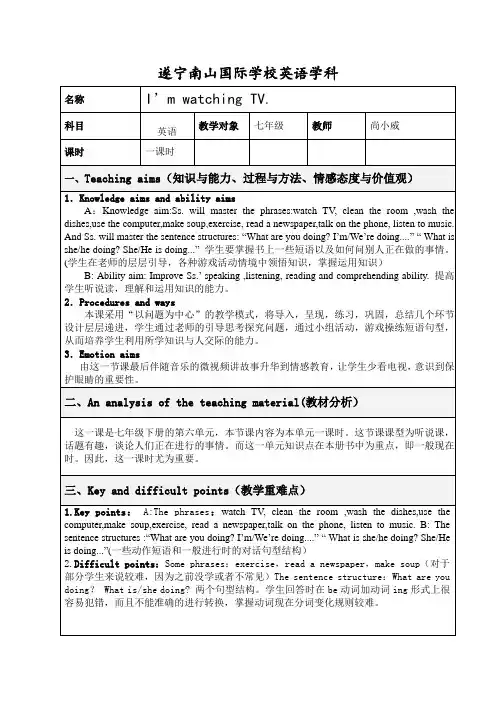
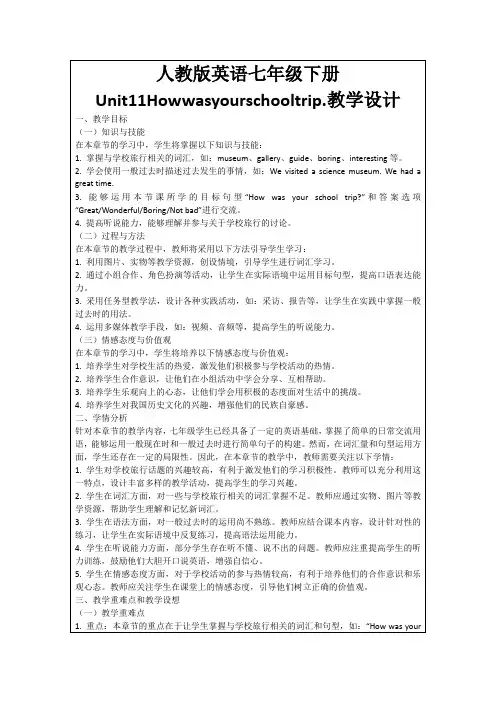
Unit 1 教学设计Title Unit 1 Can you play the guitar?Teaching aimsKnowledgeWhat club do you want to join?I want to join the … club.Can you …?Yes, I can. / No, I can’t.Can you … well?Yes, I can. / No, I can’t.Why do you want to join our … club?Because I like … / Because I can …What else can you do?I can …Skills1. Learn to talk about what they can do. Tell otherstheir strong points.2. Through practice, learn to ask others what theycan or can’t do.Emotionsand CultureTo find a job is not so easy. The chances only work forthose who are well prepared.Key wordsEnglish club, music, art, sport, chess, English poem, sing, dance, play the guitar, violin, piano, flute, trumpet, drum, paint, draw, swim, run, play chess,Chinese chess, …Important & difficult points What club do you want to join? What else can you do?Why do you want to join our club? We want … to join our club.SolvingmethodsTask-based learningTeaching Process 1. Review the words and expressions. Ask and answer.2. Want advertisements show3. Students’ example----an interview.4. Interview5. Show the interviews.6. Brief discussion7. Show the results and fill the forms out.8. Homework.TeachingaidsComputer, real object projector.Teaching proceduresTask 1 ReviewStep 1Teacher’s Activity: Lead in. “In our school there’re five clubs: English club, music club, art club, sport club and chess club. Today, these clubs come to our class and want some of you to join them”. “Do you want to join these clubs?”Students’ Activity: Listen to the teacher and answer the questions.Step 2Teacher’s activity: ask students questions:What club do you want to join?Can you…? Can you … well?Students’ activities: answer the questions.Step 3Teacher’s a ctivity: ask students questions:What club do you want to join?Can you…? Can you … well?Why do you want to join the … club?Students’ activities:Answer the questionsStep 4Teacher’s activity:ask students questions:What club do you want to join?Can you…? Can you … well?Why do you want to join the … club?What else can you do?Students’ activities:Answer the questionsTask 2 Want Advertisements ShowTeachers activity: Ask the interviewers to show their want advertisements. Ok, now the interviews are going to begin. Before the interviews, these clubscome to the dais and show their want advertisements show. Welcome!Students’ activities: The int erviewers applaud for the clubs. And the interviewers show their advertisements to the class one by one.Task 3 What can you say in interview? Show an example.Teacher’s activity: “Do you want to join these clubs? Do you know what you can say in your in terviews? Ok, I’d like to ask two of the English clubs to show an example to you.” and show the slide.Students’ activities:V olunteers in English club come to the dais and show the words and expressions. The interviewer shows the form they are going to use and fill it out according to their conversation. The other students listen to them carefully and know what to do next.Task 4 InterviewsStep 1Teacher’s activity: “Now what you can say through an interview. You’re going to fill in the forms you have according to your interviews. Now it’s time forinterviews. Let’s begin.”Students’ activities: Interview. Use the words and expressions on the slide.Step 2Teacher’s activity: Walk around the classroom and see how the interviews are going onand help some of the students if necessary.Students’ activities: Do the interviews. The interviewers fill in their forms.Task 5 Show the interviewsTeacher’s activity: Ask the students to show their interviews one by one. “Ok, time is up. Now I would like to ask one pair of each club to come here and show your interview.”Students’ activities: Show their interviews one by one.Task 6 Brief discussionTeacher’s activity: “Now I’d like to ask the interviewers to have a discussion and decide who you want.” (slide show) “You may use this sentence”. When the interviewers are discussing, hand out the forms to the students.Students’ activities: A brief discussion among the interviewers. And the others get the forms.Task 7 Show the resultsTeacher’s activity: Ask th e students to show their results. “Finished? No, show youresults. Tell us who you want. You may use this sentence: Wewant … to join us because….” (slide show) “And the otherstudents, would you please listen to them carefully and take notes,OK?”Student s’ activities: the interviewers’ spokesman come to the dais and tell the whole class to listen to the interviewers and take notes. F ill in the forms they have.Task 8 Show the final resultTeacher’s activity: “Now I’d like to ask one student to come her e and show us his or her form. He or she can use this sentence.”(Slide show) … arein … club. Ask one student to come to the real object projector andshow the others his or her form.Students’ activities: Listen to the reporter carefully.Task 9 HomeworkTeacher’s activity: Slide show first. “OK, it is the end of the interviews. After class you still have two tasks. First, the new club members, you should makea new plan for your clubs and make your forms like this.” Point tothe screen. “Your activities, time, place and the names of yourgroup members. Second, some of you haven’t found your clubsyet. So after class, you should go to some other clubs and haveinterviews with them. Find yo ur own clubs, OK?”Students’ activi ties: Listen to the teacher. Take notes if possible.Writing on blackboardUnit 1 Can you play the guitar?1. Review. Ask and answer.2. Want advertisements show3. Students’ example----an interview.4. Interview5. Show the interviews6. Brief discussion7. Show the results and fill the forms out.8. Homework.Forms for tasksForm 1 For Engli sh ClubName: ___________Club: ___________1. Can you…?²Speak English²Read in English²Sing English songs²Write English poems²Write English plays2. Can you …well?²Speak English²Read in English²Sing English songs²Write English poems²Write English plays3. Why do you want to join our club?_______________________________________________ 4. What else can you do?_______________________________________________ Form 2 For Music ClubName: ___________Club: ___________1. Can you … ?²Sing²Dance²Play the piano²Play the drum²Play the violin²Play the trumpet²Play the guitar²Play the flute2. Can you … well?²SingForm 3 For Art Club²Make oil painting²Make Chinese painting²Make flower painting²Make fruit paintin g3. Why do you want to join our club?_________________________________________ 4. What else can you do?_________________________________________ Form 4 Sport ClubName: ___________Club: ___________1. Can you … ?²Run²Swim²Play basketball²Play baseball²Play volleyball²Play soccer²Play tennis²Play ping pong²Play bowling²Play badminton2. Can you … well?²Run²Swim²Play basketball²Play baseball²Play volleyball²Play soccer²Play tennis²Play ping pong²Play bowling²Play badminton3.Why do you want to join our club?_________________________________________ 4. What else can you do?_________________________________________ Form 5 For Chess ClubName: ___________Club: ___________1. Can y ou … ?²Play chess²Play Chinese chess²Play I-go²Play black and white chess²Play flight chess²Play go bang²Play Animal chess2. Can you … well?²Play chess²Play Chinese chess²Play I-go²Play black and white chess²Play flight chess²Play go bang²Play Animal chessForm for task 9Teaching Plan for U2Teaching aims: Learn to talk about routines; learn to ask about and say times.Grammar: Simple present tense*Structure:what time questions; when questions; adverbs of frequency; That’s a funny time for breakfast(that’s a+ adj.+ time+for sth.); It’s not good for her (it’s + adj. + for sb/sth..)*Vocabulary: refer to the wordlist on P121-122Phrases: get u p, get dressed, brush one’s teeth, eat breakfast/lunch/dinner, take a shower, do one’s homework, radio station, go to work, at night, on school days, best friend, on weekends, take a walk, taste good, either…or…, lots of*Writing: learn how to write about one’s daily routines.*Sentences for writing:①I have a very healthy life.②In the morning, I get up at eight. Then I go to school at eight thirty.③I don’t have much time for breakfast.④After school, I either watch TV or play computer games.⑤At ten thirty, I brush my teeth and then I go to bed.Use the following words to write a paragraph (at least 80 words): life, never, either, exercise, quick*Passage to recite: P11 2b the first paragraphTeaching procedures:Period One:Teaching material: P7, P8 2a, 2b, 2c, P91. Lead in:2. P7 1a Match the activities with the pictures. And then put the activities into the correct order according to your own experiences.Language points:1) dress v. get dressed/dress sb. n. dress 连衣裙pl. dresses2) brush v. brush teeth 第三人称单数brushes3. P7 1b Listen and match the times with the actions. Draw lines from the clocks to the pictures.4. Pair work: Look at the picture on P7, ask and answer about Rick’s day. 操练第一,第二人称e.g. A: What time do you usually take a shower? 第一遍可让学生看图片,根据提示填空,B: I usually take a shower at six forty. 待熟练后让学生看图片完成整个问答,不给提示5. Culture Note: People in western countries are used to taking a shower after they get up in the morning. In the evening, they like to take a bath. Jim’s family members also take a shower in the morning, but they have a problem.1) Listen once and find out Jim’s problem and how they solve this problem. P8 2a Complete the sentences;2) 2b Listen again and complete the shower schedule for J im’s family.3) Pair work 1: Look at the shower schedule. Ask and answer: 操练第三人称A: When/What time does Bob take a shower?B: He always takes a shower at five thirty.Language points:1) When 可提问具体时间和大致时间/what time 只能提问具体时间2) Adverbs of frequency: always, usually, sometimes, nevere.g. I always get up at 6 o’clock.I am never late for school. 频率副词在句子中的位置,在实义动词前,be动词后。
新人教版七年级英语下册教案课堂能否进行高效率授课,学生与老师之间能否做到默契配合,教师能否让一节课的内容合理分布在课堂的每一个细节,这些都有赖于教师的教案设计是否符合学生的整体情况。
下面是小编为大家精心整理的新人教版七年级英语下册教案,仅供参考。
新人教版七年级英语下册教案(一)Unit 1 Section B (3a-Self Check)教学目标:1. 语言知识目标:1) 复习询问或谈论自己或对方在某一方面的能力和特长,讨论参加某一个俱乐部。
2) 能够综合运用所学的知识,就自己的熟悉的内容来介绍自己或他人所俱有的能力及特长;3) 总结回顾一些常见的一些表达人们能力的词汇,并能进行分类记忆。
2. 情感态度价值观目标:1) 能了解自己的一些特长,并运用自己的一技之长为他人或社会做一些有益的事情。
2)新人教版七年级英语下册教案(二)教学重难点1. 教学重点:1)2)能运用自己所学的相关英语语言知识,模仿所学过的相关材料来制作简单的广告。
2. 教学难点:的广告。
新人教版七年级英语下册教案(三)教学过程Ⅰ. Warming- up and revision1. Have a dictation of the new words and expressions.2. Let some Ss retell what Peter, Alan and Ma Huan can do.3. Let some Ss to read the three ads again.Ⅱ. Presentation1. T: Who's he?Ss: He's Liu Huan.T: What does he do?Ss: (Help Ss to answer) He's a famous musician.Write the words musician on the Bb.music 音乐→ musician音乐家拓展: teach教→teacher老师Ⅲ. Practice1. T: Next week we'll have a music festival. So we need some musicians to help with the music festival. I wrote an ad the box.2.Ⅳ. Writing3. 2b或3a中的广告的样子来写。
七年级下册英语教案人教版(优秀6篇)七年级英语下册教学计划篇一一、本学期的指导思想本人在本学期的英语教学中,坚持以下理念的应用:1、要面向全体学生,关注每个学生的情感,激发他们学习英语的兴趣,帮助他们建立学习的成就感和自信心,培养创新精神;2、整体设计目标,体现灵活开放。
3、突出学生主体,尊重个体差异;4、采用任务型的教学模式,让学生在老师的指导下通过感知、体验、实践、参与和合作等方式,实现任务的目标,感受成功;5、注重过程评价,促进学生发展,建立能激励学生学习兴趣和自主学习能力发展的评价体系。
二、教材分析本书每个单元都列出明确的语言目标、主要的功能项目与语法结构、需要掌握的基本词汇,并分为A和B两部分。
A部分是基础的语言内容,B部分是知识的扩展和综合的语言运用。
对于我们学生来说,由于小学基础不好,到初中以后学起来的确有些吃力,尤其是一千多个单词的记忆和简单的语法就吓退了不少学生学习英语的兴趣。
但我们必须知难而上,坚守教师职责,实实在在为英语教学成绩而努力。
三、教学目标对英语学习表现出积极性和初步的自信心。
能尝试使用适当的学习方法,克服学习中的困难。
常用的训练活动有以下几项:(1)Daily report:值日生介绍自己、家庭成员或朋友的情况,其它学生可互相提问题,询问个人职业。
(2)Play a guessing game:用问题“what does he do?”引入任务,让学生猜测多媒体课件中人物的职业,以此激发学生的学习兴趣,并训练学生的发散思维能力。
(3)Ask the way :创设问路情景,根据实际情况telling the way,eg. I want to go the hospital 完成对话活动。
通过训练把课内的语言学习与课外的语言活动结合起来,改变了过去老师一言堂的模式,变学生为主体,课堂主要是提供了一个学生获取知识的平台。
学生在活动中主动地获取知识。
四、具体实施方案1、加强词汇教学。
人教版初中英语七年级下册全册全套教案教学设计简介这份文档是对人教版初中英语七年级下册全册全套教案教学设计的介绍和概述。
目标本套教案教学设计旨在帮助初中七年级学生研究和提升英语能力。
教学内容本教案涵盖了七年级下册所有的英语课程内容,包括但不限于以下主题:- Unit 1: Greetings- Unit 2: School Life- Unit 3: Hobbies- Unit 4: Family and Friends- Unit 5: Food and Drinks- Unit 6: Weather- Unit 7: Daily Routine- Unit 8: Holidays and Festivals- Unit 9: Travel- Unit 10: Sports and Games教学设计教案设计采用简单的策略和教学方法,以帮助学生理解和掌握英语知识。
设计包括但不限于以下要素:- 课前导入:通过创造性的活动或问题引起学生对主题的兴趣,并激发他们的思考和讨论。
- 新课讲解:通过教师的讲解、示范和举例,向学生介绍新的词汇、语法和句型。
- 练与巩固:通过个人、小组或全班活动的练,帮助学生巩固所学内容,提高语言运用能力。
- 评估与反馈:通过测验、口语表达或其他评估方式,检查学生的研究成果,并提供及时的反馈。
注意事项在使用这套教案教学设计时,教师应注意以下事项:- 根据学生的实际情况和研究能力,灵活调整教学策略和教学内容。
- 激发学生研究英语的兴趣和积极性,营造良好的研究氛围。
- 鼓励学生多进行口语练,提高语言表达能力。
- 鼓励学生合作研究,通过小组活动培养团队合作精神。
总结这份人教版初中英语七年级下册全册全套教案教学设计为教师提供了一个简单和有效的教学工具,旨在提高学生的英语能力和兴趣。
教师在使用时可根据实际情况进行调整和适应,以达到良好的教学效果。
Unit 1 Can you play the guitar?Section A 1 (1a-2d)一、教学目标:1. 语言知识目标:1) 能掌握以下单词:guitar, sing, swim, dance, chess, play chess, draw, speak, speak English, join, club能掌握以下句型:①—Can you play the guitar? —Yes, I can./ No, I can't.②—What can you do? —I can dance.③—What club do you want to join? —I want to join the chess club.2) 能了解以下语法:情态动词can的用法want to do sth.的用法2. 情感态度价值观目标:该部分内容贴近学生的生活,谈论的话题是能力。
通过互相询问或谈论自己或对方在某一方面的能力,可以培养学生的一种群体意识。
二、教学重难点1. 教学重点:1) 学习询问和谈论彼此的能力和特长;2) 掌握一些弹奏乐器的表达方式。
2. 教学难点:情态动词can的构成和使用。
三、教学过程Ⅰ. Lead in1. 教师可携带一些易于演奏的乐器,也可带一些演奏乐器的图片,一边演示乐器,一边说: I can play the guitar.…等;再指着图片说:He/She can play the violin.But I can’t play it.等;然后询问学生:Can you play the guitar?….并引导学生进行简单的回答。
2. S s look at the picture in 1a. Then read the words and phrases. Let Ss match theactivities with the people.Then Check the answers with the class together.Ⅱ. Presentation出示一些反映各种活动的图片、幻灯片或播放课件,引导学生谈论活动:He/She can dance/swim/sing/"··But I can’t dance/swim/sing/...等,学习表达活动的动词短语。
Ⅲ. Game (What can I do?)T: Tell your partners what you can do. For example:I can play the guitar. I can sing and dance.Ss work in groups. The let some Ss talk to their classmates in front of the class. Ⅳ. Listening1. T: Now let’s listen to the tape, find out the right conversation, and number them1-3.(播放lb部分的录音让学生听,引导学生根据所听到的内容,选出对话的顺序,完成1b部分的教学任务。
)2. Check the answers: (3, 2, 1 )Ⅴ. Pair work1.Ask the Ss to practice the conversations in 1b with a partner. Then make theirown conversations.(引导学生展开Pairwork活动,完成lc部分口语交际的教学任务,学会运用can询问和表达能力。
)Ⅵ. Listening1. Work on 2a;T: Now, look at the pictures on P2, listen to the four conversations. Just listen.(Play the recording for the first time, students only listen carefully.)Then, listen to the recording again, and circle the clubs you hear.Check the answers with the class.2. Work on 2b;引导学生根据对话内容用正确的单词填空,补全对话,再播放听力材料一遍。
让学生进行校对,练习听力和写作能力,完成2b部分的教学任务。
Check the answers with the Ss.Ⅶ. Pair work1. Look at 2b and talk about what the people can do and the clubs they want to join.老师可以和一名优秀的学生做一个对话的例子,让学生们明白如何去问答,例如:T: What club does Lisa want to join?S1: She wants to join the chess club.T: Can she play chess?S1: No, she can't.2. Ss work in pairs to practice asking and answer about Lisa, Bob and Mary.3. Ask some pairs to act out their conversations.Ⅷ. Role-play1. Ask Ss to look at the picture in 2d. Then Ss read the dialogue by themselves and tryto find out the answers to these questions.①What club does Bob join?②What club does Jane join?Ss read the conversation by themselves and find the answers to the questions. Then check the answers:①Bob joins the soccer club. ②Jane joins the English and art club.2. Explain something that Ss can't understand.3. Let Ss read after the teacher or play the recording and let Ss read after therecording.4. Ss work in pairs to act out the conversation.5. Ask some pairs come to the front of the classroom. They try to act out the conversation. See which group is the best.Homework:1. Remember the new words and expressions after class.2. Recite the conversation after class.3. Write English names as many as possible in the exercises book.Section A 2 (Grammar Focus-3c)一、教学目标:1. 语言知识目标:1) 继续练习运用情态动词can。
学会询问和谈论彼此的能力和特长。
能掌握以下句型:①—Can you play the guitar? —Yes, I can./ No, I can't.②—What can you do? —I can dance.③—What club do you want to join? —I want to join the chess club.2. 情感态度价值观目标:该部分学习询问或谈论自己或对方在某一方面的能力和特长,可以培养学生的一种群体意识,促进同学们对自身的认识,为将来的自我发展奠定基础。
二、教学重难点1. 教学重点:1) 让学生重点总结、发现情态动词can的用法。
2) 通过一些与学生们实际生活相贴近的教学活动,来达到熟练运用的目的。
2. 教学难点:1) 情态动词can的用法;2) 在实际交际活动中运用can来询问与表达自己或他人的能力。
三、教学过程Ⅰ. Warming- up and revision1. Ask some Ss about their abilities.T: Hi, S1! What can you do?S1: I can sing and dance?T: Can you play the guitar?S1: Sorry, I can't. But I can play chess.T: What club do you want to join?S1: I want to join the chess club.2. Role-play.Let some pairs role play the conversation in 2c.Ⅱ. Grammar Focus.1. 阅读指导:2. 学生阅读Grammar Focus中的句子,然后做填空练习。
①你会游泳吗?______ you ______?②是的,我会。
/ 不,我不会。
Yes, ____ _______. / No, I _______.… (其余试题见课件部分)3. 学生们完成填空试题后,可以打开课本检查答案,对错误的句子,单独进行强化记忆。
Ⅲ. Try to Find老师将情态动词的can的用法,以学案的方式呈现在大屏幕上,让学生自主学习,并发现其用法。
1. 可以看出,在Can…?句型中,情态动词can没有________和_______ 的变化。
2. 用情态动词can来询问他人的能力可以归纳为以下句型:Can + _______ + _________ + 其他?肯定回答:_________________否定回答:_________________What + can + _______ + ________ ?学生们合作学习讨论上面学案的答案,总结情态动词can的用法。
老师找部分学生对上述问题作答,并一起讨论总结情态动词can的用法。
Ⅳ. Practice1. Look at 3a. 告诉学生们用所给的词汇来造句子。